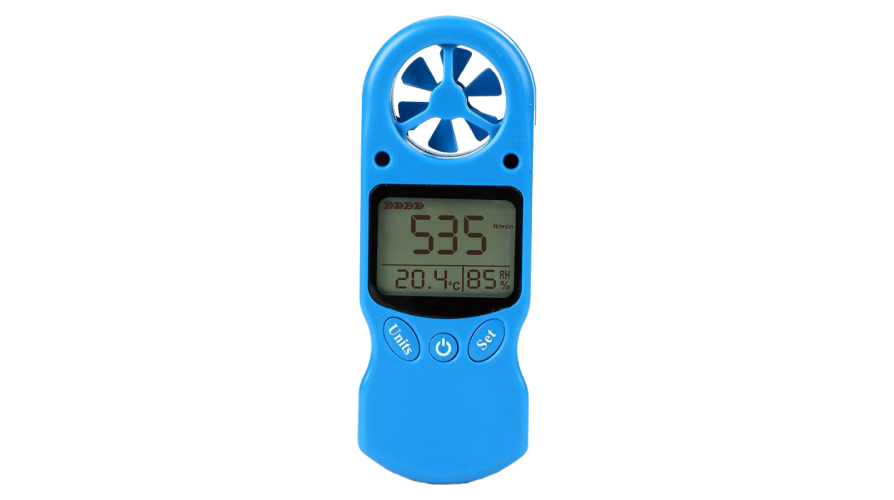Picking the Right Anemometer: A Comprehensive Buying Guide
Picking the Right Anemometer: A Comprehensive Buying Guide
Blog Article
All You Required to Learn About Anemometers: Exactly How They Work, Why They Matter, and Where to Make use of Them
Anemometers, though commonly neglected in the world of clinical tools, play a crucial duty in numerous fields, providing valuable insights right into wind rate and air flow patterns. As we dig right into the ins and outs of anemometer modern technology, we will certainly uncover the internal functions of these devices, their value, and the vital factors to consider when picking the appropriate anemometer for particular applications.

Anemometer Essentials
A necessary instrument utilized to measure wind speed and instructions, the anemometer plays a critical duty in meteorology and numerous sectors. An anemometer typically is composed of 3 or four cups that turn in the wind, a vane that points into the wind, and sensing units to track the activities or rotations. By calculating the rotations or motions over a details amount of time, the anemometer can determine wind speed. The vane helps determine wind direction by pointing into the wind, providing beneficial information for weather condition forecasting, air travel, maritime procedures, environmental surveillance, and wind power applications.
There are different kinds of anemometers offered, consisting of mug anemometers, vane anemometers, hot-wire anemometers, and sonic anemometers, each with its unique functions and applications. Mug anemometers are typically used for basic wind speed measurements, while vane anemometers are preferred for directional measurements. Hot-wire anemometers appropriate for low airspeeds, and sonic anemometers are ideal for high-precision measurements in research and industrial settings. Comprehending the fundamentals of anemometers is crucial for accurate wind data collection and analysis throughout various sectors.
Concepts of Anemometer Operation
Building on the foundational understanding of anemometer essentials, the concepts of anemometer procedure illuminate the technicians behind wind rate and direction dimensions. Anemometers operate on the concept of airflow impacting a sensing unit, causing it to revolve. Cup anemometers, as an example, have 3 or more mugs that capture the wind, causing them to spin faster as the wind rate boosts. The turning rate is then exchanged a wind speed measurement. Vane anemometers, on the various other hand, utilize a tail or a probe that aligns itself with the wind instructions, providing a dimension of wind instructions based upon the orientation of the sensing unit. Hot-wire anemometers count on a heated cable that cools down as wind overlooks it, with the price of cooling down establishing the wind visit the site speed. Ultrasonic anemometers measure wind speed and direction by examining the time it considers ultrasonic signals to take a trip in between transducers. Understanding these principles is crucial for precise and reliable wind measurements in numerous applications.
Relevance of Anemometers
Anemometers play an important function in determining wind rate and direction, offering vital information for weather condition projecting, climate research studies, ecological surveillance, and aviation procedures. Meteorologists count on anemometers to collect exact wind information, assisting them comprehend weather patterns, anticipate storms, and issue timely cautions to the public. Wind ranch drivers utilize anemometers to examine wind problems and make best use of electrical power manufacturing from wind turbines.
Applications Across Different Industries
Applications of anemometers span across varied industries, showcasing their adaptability and utility beyond weather forecasting. In the renewable resource market, anemometers play a vital function in assessing wind problems for wind farm positionings, guaranteeing optimum energy manufacturing. Industries like building and mining make use of anemometers to keep an eye on wind speeds, critical for safety and security procedures, specifically when operating at elevations or in open-pit mines where solid winds can position threats. Anemometers are likewise indispensable in the air travel market, helping pilots in recognizing airspeed and wind instructions for risk-free liftoffs and touchdowns. The maritime field gain from anemometers for ship navigating, assisting seafarers prepare for climate modifications and readjust paths accordingly. In agriculture, anemometers help farmers in taking care of websites crop spraying by giving real-time data on wind speed to stay clear of drift. Furthermore, anemometers discover applications in HVAC systems to enhance air movement and enhance energy effectiveness in structures. The varied usage instances of anemometers highlight their value throughout different sectors, highlighting their important duty in boosting functional safety and security and efficiency (anemometer).

Selecting the Right Anemometer for Your Needs
Picking the proper anemometer tailored to your particular demands is essential for acquiring precise wind speed and direction dimensions. When choosing an anemometer, take into consideration elements such as the intended application, required measurement array, ecological conditions, and desired attributes. For basic objectives, a cup anemometer appropriates for measuring wind rate, while a vane anemometer supplies wind direction data. Hot-wire anemometers are suitable for reduced airspeed measurements, and ultrasonic anemometers use high accuracy and longevity.

Final Thought
In verdict, anemometers play an essential duty in measuring wind speed and direction throughout different markets. It is important to take into consideration the significance of anemometers in order to make educated choices when picking the most appropriate tool for determining wind conditions.
There are numerous kinds of anemometers available, consisting of mug anemometers, vane anemometers, hot-wire anemometers, and sonic anemometers, each with its special functions and applications. Mug anemometers are generally used for fundamental wind rate dimensions, while vane anemometers are chosen for directional dimensions. Hot-wire anemometers are appropriate for low airspeeds, and sonic anemometers are ideal for high-precision dimensions in research and industrial settings.Structure on the foundational understanding of anemometer essentials, the concepts of anemometer operation clarify the mechanics behind wind speed and direction measurements. For basic functions, a mug anemometer is appropriate for gauging wind speed, while a vane anemometer gives wind direction information.
Report this page